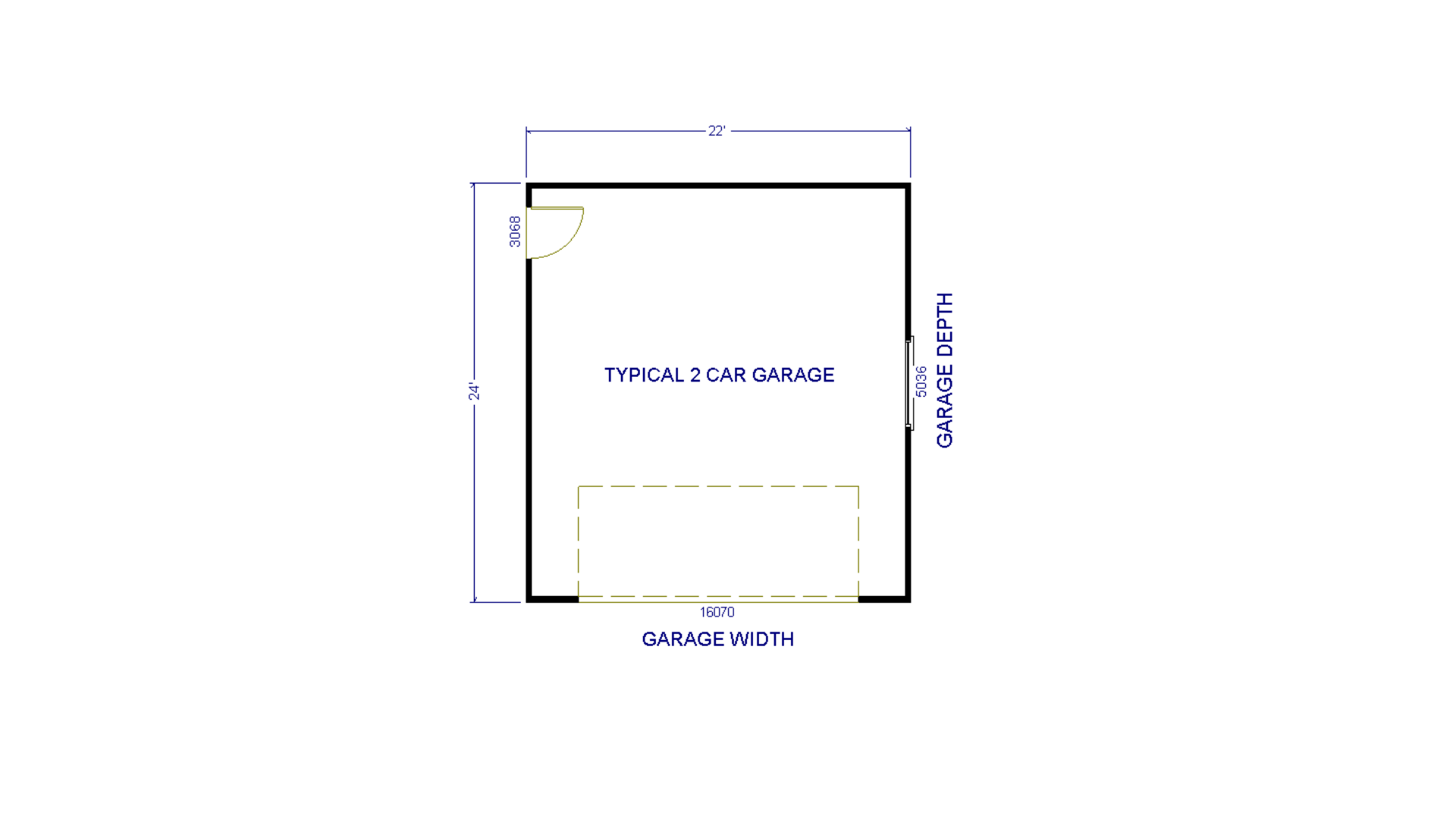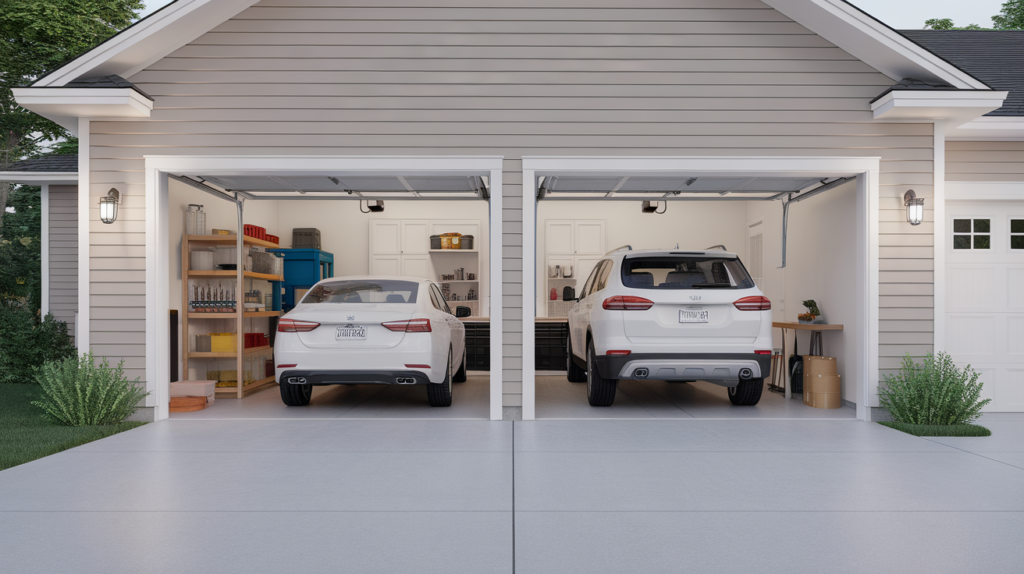Determining the size of a 2-car garage can be confusing.
Perhaps you’re building a new one or checking if your current space can accommodate two cars, some storage, and still allow you to move around.
I get it, it’s not just about parking, but also about how the space works for your life. You might need extra room for bikes, tools, or just enough space to open car doors without a squeeze.
I’ve put together everything you need to know to help you make the right call.
You’ll find clear answers about common garage sizes, what’s considered standard, and how to figure out if those numbers really work for you.
No guessing, just simple and useful information. Let’s make sure your space fits your needs the first time around.
What Is a 2-Car Garage?

A 2-car garage is a space built to fit two cars side by side. It typically features one large door or two smaller ones, and it either connects to your house or stands independently.
The main goal is to provide you with enough room to park both cars and still have space to move around a bit.
Some garages are just wide enough to fit the cars, while others provide a bit more space for items like bikes, tools, or shelves.
Not every 2-car garage is the same size, but they all try to do the same job: keep your cars safe and out of the weather.
If you’re considering building or using a two-car garage, knowing the typical size helps you plan more effectively.
That way, you won’t feel stuck with a space that’s too small for your needs.
How to Know What Size You Really Need
Not everyone needs the same size garage. It depends on what you plan to keep inside and how much space you want to move around.
Start by thinking about your cars. Are they small like a sedan or larger like an SUV or truck?
Bigger cars need more space, especially so you can open the doors without bumping into walls or each other.
Next, think about what else you’ll store. Bikes, lawn tools, shelves, or a freezer? All those things take up space, too.
If you want a little room to work on hobbies or just walk comfortably, you might want something a bit bigger than the standard size.
Also, check how wide your driveway is. That can affect how wide your garage should be. Taking a few measurements now helps avoid problems later.
It’s easier to plan ahead than to wish you had added more space.
Common Sizes for a 2-Car Garage

Here’s a simple look at the usual sizes for a 2-car garage:
- Width: Most are around 22 feet wide.Enough space to park two cars side by side
- Depth: Usually 20 to 24 feet deep.Gives you room to open doors and maybe store a few items
- Wall Height: Commonly 8 to 10 feet tall.Room for shelves or overhead storage
- Door Height: Typically 7 to 8 feet high.Fits most cars, including small trucks and SUVs
- Door Width: A single large door is often 16 feet wide, or two separate 8-foot doors.Based on design choice and driveway setup
- Extra Room Needs: If you have larger vehicles or need storage, consider 22 by 24 feet or more.
What Can Change the Size You Need
A few simple things can make a big difference when it comes to how big your 2-car garage should be:
- Vehicle Type: Bigger cars like SUVs or trucks need more space than smaller ones. If both cars are large, it’s best to have extra width and depth for a better fit.
- Extra Items: Think about what else you’ll store: bikes, lawnmowers, tools, or a second fridge. Even small things like shelves or bins along the walls take up space.
- Room to Move: You need space to open doors, walk around, and carry things in or out. A tight garage can be frustrating, especially with two people moving at the same time.
- Suspension Lifts: If your vehicles have SuspensionLifts, they’ll require additional height clearance in your garage to accommodate the raised stance.
Understanding 2-Car Garage Door Sizes

The right garage door size can make parking easier and prevent damage. Here are the key points to know:
Standard Double Door:
- Usually 16 feet wide by 7 feet high
- Great for easy access without needing perfect alignment
- Works well for most standard-sized vehicles
Two Single Doors:
- Typically 8 to 9 feet wide each
- Offers a separate space for each car
- May cost more due to extra hardware and openers
Clearance Matters:
- Make sure there’s space for the door to open fully
- Check that your driveway lines up with the garage
Vehicle Height:
- If you have a taller vehicle, check the door height to avoid scraping or tight fits
Choosing the right layout depends on your space, budget, and how you like to use your garage
How to Turn Your Garage into a Multi-Use Space?

A garage isn’t just for parking; it often becomes a place to store all kinds of things.
If you know you’ll need extra space for tools, a workbench, or even a freezer, it’s smart to plan. If you’re also considering future upgrades like installing a vehicle lift, it’s worth learning do 4 post lifts need to be bolted down, since that can affect how much floor space and reinforcement your garage design requires. Adding just a few more feet to the depth or width can make a big difference.
Do you want to hang bikes or store sports gear? You’ll need wall or ceiling space that’s easy to reach.
Make sure there’s room to stand, move, and store tools without crowding your cars.
Some people use one side of the garage primarily for storage and the other for parking. Others add shelves or cabinets along the walls.
Regardless of your choice, it is helpful to measure everything before you build or upgrade.
That way, your garage fits your whole lifestyle, not just your vehicles.
Tips for Planning Your 2-Car Garage
Below are some simple tips to help you design a garage that works well now and later:
- Plan for Growth: Leave extra room in case you get a bigger car, a second freezer, or more gear in the future.
- Keep It Simple: A clean, open layout makes parking and moving around easier. Avoid cluttered corners.
- Think Ahead: If you’ll add shelves or cabinets later, make sure you leave space for them now.
- Use Wall and Ceiling Space: Hanging storage or tall shelves can free up floor space.
- Leave the Walking Room: Make sure there’s enough space to walk around both cars without squeezing.
- Check Door Swings: Ensure your garage doors and car doors can open fully without bumping into walls or each other.
- Consider Lighting and Outlets: Plan spots for lights and power, especially if you’ll use the space for work or storage.
Conclusion
Building or updating a 2-car garage takes more than guessing the size.
I’ve shared the typical measurements, which are about 20 feet wide and 20 to 24 feet deep, but that’s just the starting point.
What matters most is how you plan to use the space. Think about your car size, storage needs, and how much room you want to move around.
If you drive larger vehicles or need a workbench, freezer, or extra storage, adding a few feet can make the space feel more usable.
I always suggest measuring everything, your cars, the driveway, and anything else you’ll keep in the garage, before making final plans.
A garage that fits well now and still works years later is a smart choice.
If it’s for parking, storage, or a combination of both, careful planning helps avoid mistakes and provides you with a space that truly meets your everyday needs.

